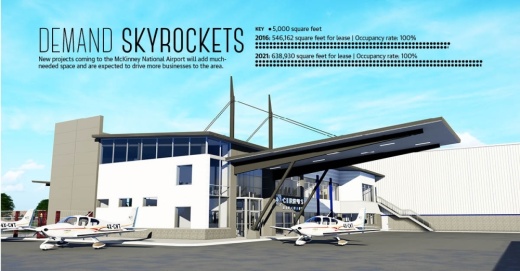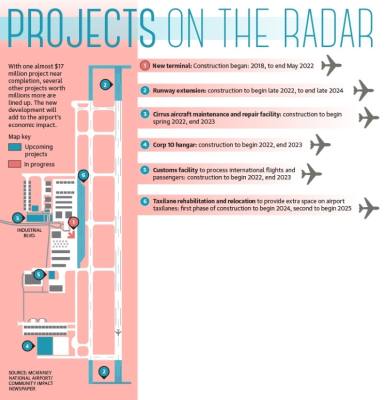In May, McRight-Smith Construction should be finished or close to finishing the airport’s new terminal, which will provide a gateway to the city with heightened amenities from the existing McKinney Air Center, Airport Director Ken Carley said.
But the terminal is just the tip of the iceberg, as the McKinney National Airport prepares to plunge into an additional $110 million worth of projects, officials said. Among these are a new customs facility for international travelers, more hangar space and a runway expansion. In addition, a new aircraft maintenance and repair facility owned by Cirrus Aircraft is expected to break ground this spring.
Projects like these are needed as the airport continues to turn away customers who are interested in leasing out space at the airport, Carley said. For some time, the airport has been and continues to operate at 100% occupancy.
“We can’t seem to build hangars fast enough. As soon as one is complete, it’s already fully booked,” Carley said. “We’ve had people who have been on a waiting list for more than a year to get space here.”
The demand at the airport, which provides general aviation services, such as private business flights, flight training and medical transport, is one indicator of its success. A 2018 Texas Aviation Economic Impact Study released by the Texas Department of Transportation found that the airport at the time had an economic impact of more than $212 million annually to the city of McKinney and the region.
This is almost five times the economic impact the airport had from the previous study that was published in 2011. Carley said the $212 million figure is now outdated.
“We’ve had millions of dollars of investment since then,” Carley said. “The rate of growth is becoming steeper and steeper, and the next time we do [a study], it’ll probably be even larger.”
The airport has plenty of space to grow, with about 40 acres on its west side left to develop, Carley said. Looking ahead 20 years, the economic impact from the airport could be “in the billions,” he said.
“It’s really not just the city of McKinney impacted. It’s regional, and the bigger it gets, probably the more regional that economic output becomes. That’s exciting. There’s not a lot of [general aviation] airports in the state that are probably growing at the rate we’re growing,” Carley said.
These projects and the new terminal all help the airport to convince more companies to choose McKinney National Airport over other destinations. As the airport grows and develops, that helps retain, grow and attract more companies and corporate partners, Mayor George Fuller said.
“The airport benefits every single resident, every single business in the city of McKinney,” Fuller said.
He explained that corporate jets and planes, which are “very expensive,” pay property and school taxes, with the added benefit of not creating any extra burden of sending children to the school system or driving on the roads.
“The more that inanimate objects like that pay a property tax and school tax, the less parents, homeowners, business owners are paying,” Fuller said. “So there’s a huge benefit because we’re talking hundreds of millions of dollars of value.”
A ‘jewel’ for the airport
Since 1979, the city of McKinney has owned McKinney National Airport. In 2013 the city also purchased the McKinney Air Center. This one-stop shop for planes and pilots provides fuel, plane storage and concierge services such as rental cars and catering.
The 15,000-square-foot center functions as the current front door to the airport for pilots and travelers. The new terminal that will be completed this spring will not only add 2,000 square feet, but will also be a better space to operate out of, said Andrew Smith, president of McRight-Smith.
“It’s laid out a little better. The other one was getting dated. It’s been around for 30 or 40 years,” Smith said. “The foyer in this one is really attractive. ... You walk in and it’s a big, attractive open foyer with very high ceilings, lots of light coming through.”
Ceiling-to-floor glass windows on the terminal’s second floor will provide expansive views of not only the immediate runway, but the rest of the airfield as well, Smith said.
“I think it’ll be a real jewel for the airport once it’s done,” Smith said.
The new terminal was originally scheduled for completion last year, but was set back with supply chain issues, Smith said. When it opens, the airport’s staff will move over to the new terminal, freeing up space in the McKinney Air Center that can also be leased. However, all of the newly created space is already spoken for, Carley said.
“We have people waiting to lease the space pretty much immediately,” he said.
In addition to the new terminal, the airport added 10 new executive hangars over 2.2 acres in September. The project was privately funded by the developer, who has already sold the hangars to tenants. The projects created an estimated economic impact of about $6.6 million to the community, airport documents show.
More projects on the horizon
This summer construction will start on Cirrus Aircraft’s new maintenance and repair facility, which will add an estimated $14.5 million in capital improvements to the airport over about 4 acres, Carley said. The project will serve as an administrative facility for the aviation company that makes and sells aircraft and personal jets.
After opening a satellite office in McKinney last year, Cirrus will gain space for aircraft storage, service hangars and a two-story office with the new facility.
“Cirrus Aircraft conducted a nationwide search to identify the most ideal locations for its newest facilities and ultimately determined that [McKinney National Airport] was best suited for our current needs,” a Cirrus Aircraft spokesperson said in an email. “We considered several factors in selecting our locations, including customer experience, airspace and airport facilities, workforce, cost of operations and economic incentives.”
Documents from the airport show that an estimated 50 full-time jobs are expected with the new facility. The project is privately funded, with Cirrus leasing the land from the airport. The McKinney Economic Development Corp. also offered $1.4 million in incentives for the project, Carley said.
Another project the airport has in its sights is creating more general aviation hangar space to store aircraft. The last general hangar project it completed in April 2019 was 100% full in 45 days, Carley said.
“We’ve turned away more than enough business to fill another one since then,” he said.
Hangars generate revenue through rent and aircraft fuel sales, as well as the sale of other services to the aircraft, Carley said.
That revenue from the new hangar is expected to support the debt on building not only the hangar, but also a new customs building, he said.
“Customs isn’t really going to generate revenue, but it’s needed,” Carley said. “We’re serving those customers today, and that’s to process international arrivals.”
Engineering and design on those two projects will take place this year, with construction potentially starting in late 2022, Carley said.
Additional projects the airport is tackling include erosion repair and the rehabilitation and relocation of taxiways, Carley said.
A path for more passengers
One of the biggest upcoming projects for the airport has been on its radar for a number of years and will get underway later this year, Carley said. Design work began last year to extend the airport’s southern runway by 500 feet, and construction on that project is expected to begin in November or December.
The runway will ultimately be extended by 1,500 feet, going from 7,002 feet to 8,502 feet. Work will be in two phases, with the first consisting mainly of infill and drainage to get the land leveled, Carley said. The second phase will involve pavement and connecting the runway. If the project remains on schedule, it should be completed by the end of 2024, Carley said.
Having a longer runway opens up more possibilities for airport travelers, Carley said. The more fuel airplanes leave with, the more runway space is needed to get them airborne. With the extension, planes leaving from McKinney National Airport can carry enough fuel for longer flights.
“Some of our operators that use the airport today are limited in the sense that if they’re flying really long trip legs overseas ... they can’t make it in one trip because they can’t take enough fuel out of here,” Carley said.
In addition, an extended runway will attract more operators who are currently in the area, Carley said.
“It’ll allow the airport to grow unencumbered for decades to come, which is really the goal of it,” Carley said.
Looking ahead, airport officials are weighing the possibility of adding commercial passenger flights in the future.
“It’s an expensive undertaking, not only for us, but for any airline that would look to come in here and serve too,” Carley said.
To be certified by the Federal Aviation Administration to provide commercial flight services, McKinney National Airport would have to add even more staff and facilities, Carley said. The airport can apply for federal government grants to cover some of the costs for these services.
“The goal is, if we grow in that direction, we can still be self-supporting and at an operating cost for the airlines so that it makes sense for them to be there,” Carley said. “We’re going through this whole due diligence to make sure it makes sense. I feel like in the end, it probably will.”







